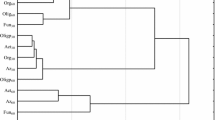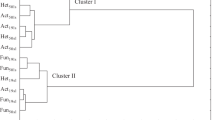Abstract
The objective of this study was to determine the effects of two insecticides, namely, acetamiprid and carbofuran on the enzymatic activities of arylamidase (as glucose formed from sinigrin) and myrosinase (as β-naphthylamine formed from l-leucine β-naphthylamide) in the black and red clay soils collected from a fallow groundnut (Arachis hypogaea L.) fields in the Anantapur District, Andhra Pradesh, India. The study was realized within the framework of the laboratory experiments in which the acetamiprid and carbofuran were applied to the soils at different doses (1.0, 2.5, 5.0, 7.5, 10.0 kg ha−1). Initially, the physicochechemical properties of the soil samples were analyzed. After 10 days of pesticide application, the soil samples were analyzed for the enzyme activities. Acetamiprid and carbofuran stimulated the arylamidase and myrosinase activities at lower concentrations after 10 days incubation. Striking stimulation in soil enzyme activities was noticed at 2.5 kg ha−1, persists for 20 days in both the soils. Overall, higher concentrations (5.0–10.0 kg ha−1) of acetamiprid and carbofuran were toxic or innocuous to the arylamidase and myrosinase activities. Nevertheless, the outcomes of the present study clearly indicate that the use of these insecticides (at field application rates) in the groundnut fields (black and red clay soils) stimulated the enzyme (arylamidase and myrosinase) activities.


Similar content being viewed by others
References
Acosta-Martinez V. (2000). Arylamidase activity of soils. Iowa State University, Digital Repository at Iowastate university, Retrospective Thesis and Dissertations (pp. 1–205).
Acosta-Martinez V., & Tabatabai M. A. (2000). Arylamidase activity in soils. Soil Science Society of America Journal, 64, 215–221.
Angus, JF., Grander, PA., Kirkegaard, JA., & Desmarchelier, JM. (1994) Biofumigation: isothiocyanates released from Brassica roots inhibit growth of the take all fungus. Plant and Soil, 162, 107–112.
Appel W., & Peptidases (1974). In H. U. Bergmeyer (Ed.), Methods of enzymatic analysis (vol. 2, pp. 949–954). New York: Academic Press.
Barnes H., & Folkard B. R. (1951). The determination of nitrite. Analyst, 76, 599–603.
Brown, PD., &Morra, MJ. (1997) Control of soil borne plant pests using glucosinolate-containing plants. Advances in Agronomy, 61, 167–231.
Di Sanzo C. P. (1981). Effect of foliar application of carbofuran and a related compound on plant parasitic nematodes under greenhouse and growth chamber conditions. Journal of Nematology, 13(1), 20–24.
Dudani, AT., & Sengupta, S. (1992) Intensive use of agricultural chemicals in India and their ecological and environmental impacts, In:Third Agricultural Science Congress. PAU, Ludhiana.
El-Banhawy, EM., El-Boaolossy, MA., & Aeia, SI. (1998) Effect of the nematicide carbofuran on the population development of the citrus parasitic nematode tylenchulus semipenetrans and predacious soil mites in citrus orchard under organic manure regime of fertilization. Anzeiger für Schädlingskunde Pflanzenschutz Umweltschutz, 71, 69–71.
Fliessbach A., & Mader P. (2004). Short and long term effects on soil microorganisms of two potato pesticide spraying sequences with either glufosinate or dinoseb as defoliants. Biology and Fertility of Soils, 40, 268–276.
Floch C., Anne-Celine C., Karine J., Yvan C., & Steven C. (2011). Indicators of pesticide contamination: soil enzyme compared to functional diversity of bacterial communities via biolog ecoplates. European Journal of Soil Biology, 47, 256–263.
Getenga N. C., & Weil R. R. (2006). Elements of thenature and properties of soils (p. 5). Englewood Cliffs: Prentice Hall.
Gil V., & MacLeod A. (1980). The effect of pH on glucosinolate degradation by a thioglucoside preparation. Journal of Phytochemistry, 19, 2547–2553.
Hart, MR., & Brookes, PC. (1996) Soil microbial biomass and mineralization of soil organic matter after 19 years of cumulative field applications of pesticides. Soil Biology and Biochemistry, 28(12), 1641–1649.
Hiwada K., Yamaguchi C., Inaoka Y., & Kokubu T. (1977). Neutral arylamidase in urine healthy and nephritic children. Clinica Chimica Acta, 75, 31–39.
Hiwada K., Ito T., Yokoyama M., & Kokubu T. (1980). Isolation and characterization of membrane-boundarylamidases from human placenta and kidney. European Journal of Biochemistry, 104, 155–165.
Jaffer Mohiddin G., Srinivasulu M., Subramanyam K., Madakka M., Meghana D., & Rangaswamy V. (2013). Influence of insecticides flubendiamide and spinosad on biological activities in tropical black and red clay soils. 3Biotech, 5, 13–21.
Jaya Madhuri R., & Rangaswamy V. (2009). Biodegradation of selected insecticides by Bacillus and Pseudomonas sps. In groundnut fields. Toxicology International, 16, 127–132.
Johnsen, K., Jacobsen, CS., Torsvik, V., & Sorensen, J. (2001) Pesticide effects on bacterial diversity in agricultural soils-a review. Biology and Fertility of Soils, 33, 443–453.
Johnson, CM., & Ulrich, A. (1960) Determination of moisture in plant tissues. California Agriculture Bulletin, 766, 112–115.
Kalam A., & Mukherjee A. K. (2001). Influece of hexaconazole, carbofuran and ethion on soil microflora and dehydrogenase activities in soil and intact cell. Indian Journal of Experimental Biology, 39, 90–94.
Megharaj M., Kookana K., & Singleton S. (1999). Activities of fenamiphos on native algae population and some enzyme activities in soil. Soil Biology and Biochemistry, 39, 1549–1553.
Pal R., Chakrabarti K., Chakraborty A., & Chowdhury A. (2005). Pencycuron application to soils. Degradation and effect on microbiological parameters. Chemosphere, 60, 1513–1522.
Parr J. F. (1974). Effects of pesticides on microorganisms in soil and water. In W. D. Guenzi (Ed.), Pesticides in soil and water (pp. 315–340). Madison: Soil Science Society of America.
Pimentel D. (1995). Amounts of pesticides reaching target pests: environmental impacts ethics. Journal of Agricultural and Environmental Ethics, 8, 17–29.
Qui, F.Q., Zhou, LK.,Chem, EF., Ding, QT., Zhang, AM., & Dang, L. (1981) Relationships between organic matter and enzymatic activities and soil fertility in Merk soils. Acta Pedologica Sinica, 18, 244–254.
Ramakrishnan B., Megharaj M., Venkateswarlu K., Naidu R., & Sethunathan N. (2010). The impacts of environmental pollutants on microalgae and cyanobacteria. Critical Reviews in Environmental Science and Technology, 40, 699–821.
Ranney, TA., & Bartlett, RJ. (1972) Rapid field determination of nitrate in natural waters. Communications in Soil Science and Plant Analysis, 3, 183–186.
Rask, L., Andreasson, E., Ekbom, B., Eriksson, S., Pontoppi- dan, B., & Meijer J. (2000) Myrosinase: gene family evolution and herbivory defense in Brassicaceae. Plant Molecular Biology, 42, 93–113.
Sanchez, MM., Moreno, M., Arrebola, FJ., & Vidal, JLM. (2003) Analysis of acetamiprid in vegetables using gas chromatography-tandem mass spectrometry. Analytical Sciences, 19, 701–704.
Singh L., Squire, & Strauss J. (1986). Agricultural household models: extensions, applications and policy. Baltimore: John Hopkins University Press.
Singh, BK., & Walker, A. (2006) Microbialdegradation of organophosphoruscompounds. FEMS Microbiology Review, 30, 428–471.
Skujins J. J. (1978). History of abiotic soil enzyme research. In R. G. Burns (Ed.), Soil enzymes (pp. 1–49). New York: Academic Press.
Srinivasulu M., & Rangaswamy V. (2013). Influence of insecticides alone and in combination with fungicides on enzyme activities in soils. International Journal of Environmental Science and Technology, 10(2), 341–350.
Srinivasulu, M., & Rangaswamy, V. (2014). Enzymes and Pesticides: In Enzymes in agricultural sciences. Editors: Liliana Gianfreda and Maria A Rao. Publishers: OMICS Group e Books. Gull Ave, Foster City. pp. 25.
Srinivasulu M., Mohiddin G. J., Subramanyam K., & Rangaswamy V. (2012). Effect of insecticides alone and in combination with fungicides on nitrification and phosphatase activity in two groundnut (Arachishypogeae L.) soils. Environmental Geochemistry and Health, 34, 365–374.
Tabatabai M. A. (1994). Soil enzymes. In W. A. Dick (Ed.), Methods of soil analysis, 2. Microbiological and biochemical properties (pp. 775–833). Madison: Soil Science Society of America.
Tu, CM., & Miles, JRW., (1976) Interaction between insecticides and soil microbes. Residue Reviews, 64, 17–65.
Turki, AI., & Dick, AW. (2003) Myrosinase activity in soil. Soil Science Society of America Journal, 67, 139-145.
Wilson C., & Tisdel C. (2001). Why farmers continue to use pesticides despite environmental, health and sustainability costs. Ecological Economics, 39, 449–462.
Acknowledgments
The authors are grateful to the University Grants Commission Special Assistance Programme (UGC-SAP), New Delhi, India, for financial assistance (UGC S.LR. No. F.3-25/2009) and in part the Secretaria Nacional de Educación Superior Ciencia y Tecnología (SENESCYT), Ecuador.
Conflict of interest
The authors declare that they have no competing interests.
Author information
Authors and Affiliations
Corresponding author
Rights and permissions
About this article
Cite this article
Jaffer Mohiddin, G., Srinivasulu, M., Maddela, N.R. et al. Influence of the insecticides acetamiprid and carbofuran on arylamidase and myrosinase activities in the tropical black and red clay soils. Environ Monit Assess 187, 388 (2015). https://doi.org/10.1007/s10661-015-4631-2
Received:
Accepted:
Published:
DOI: https://doi.org/10.1007/s10661-015-4631-2




